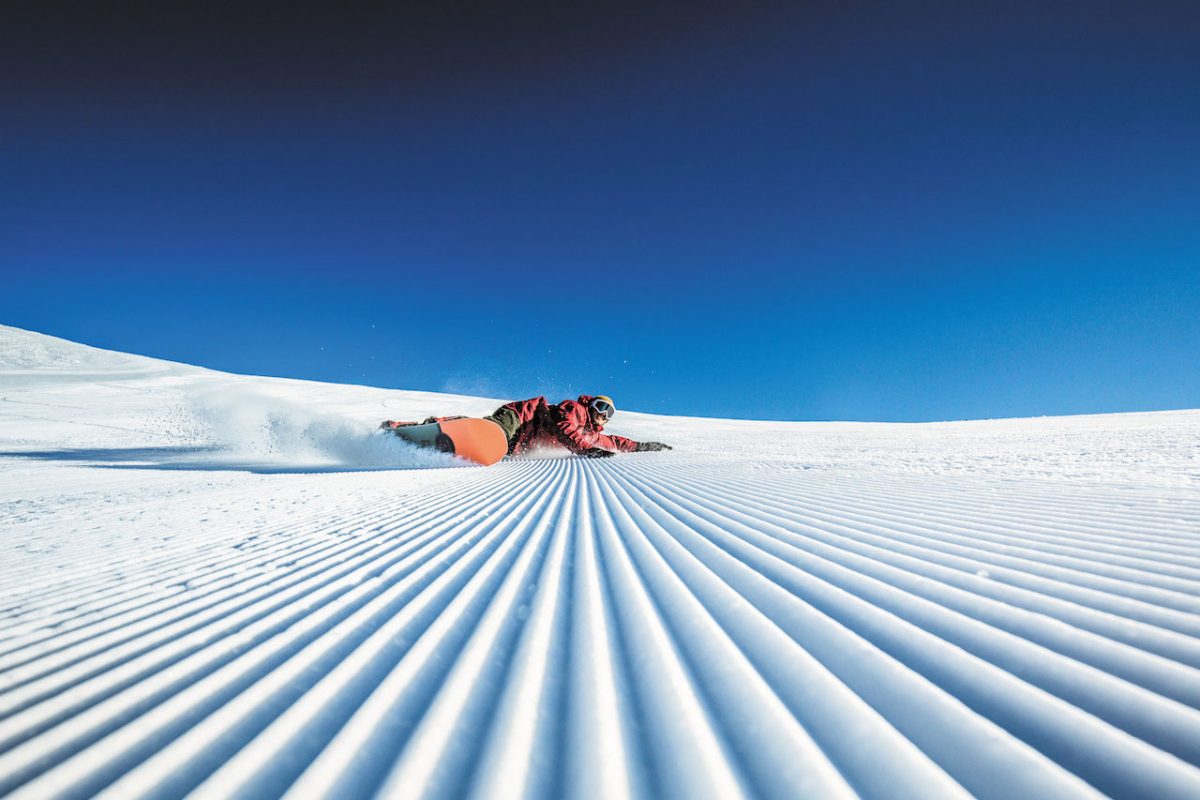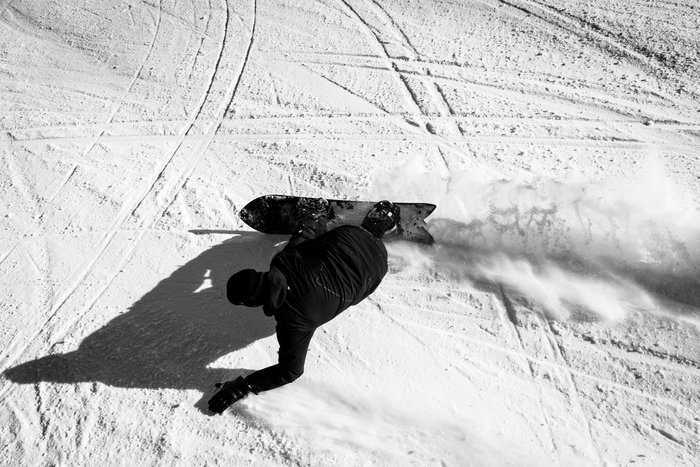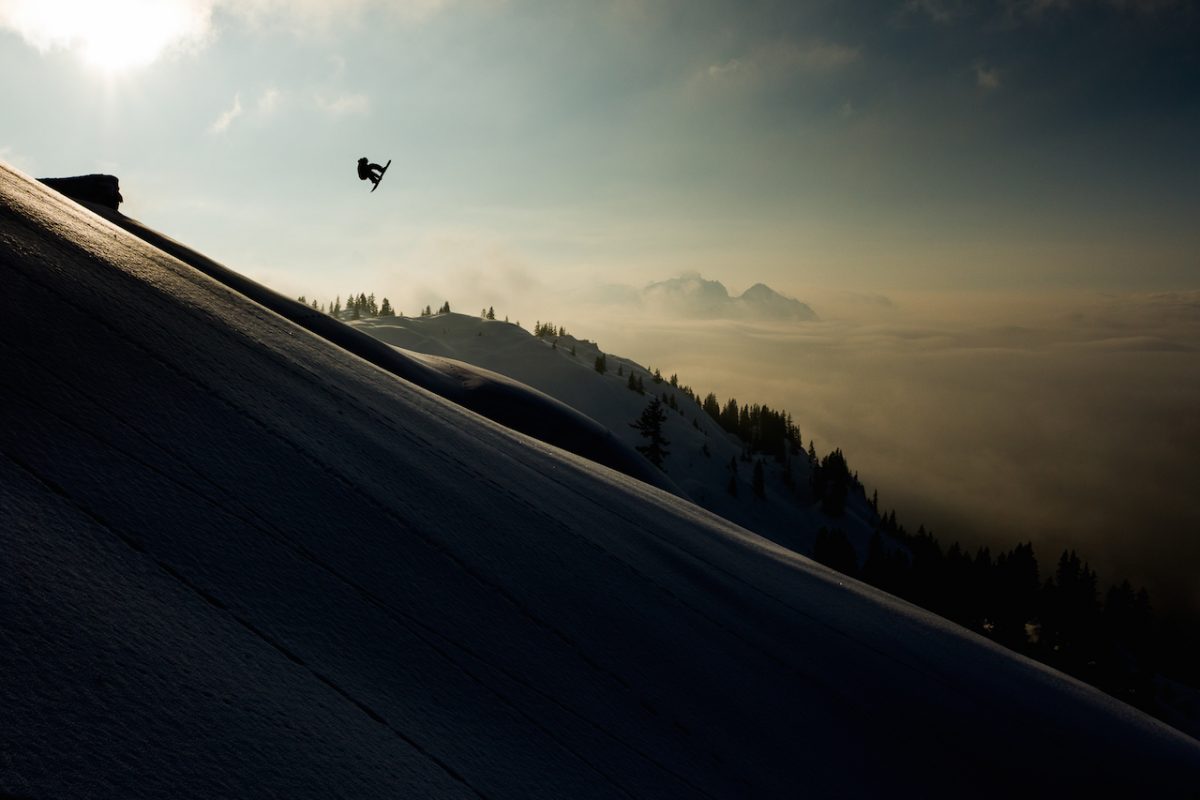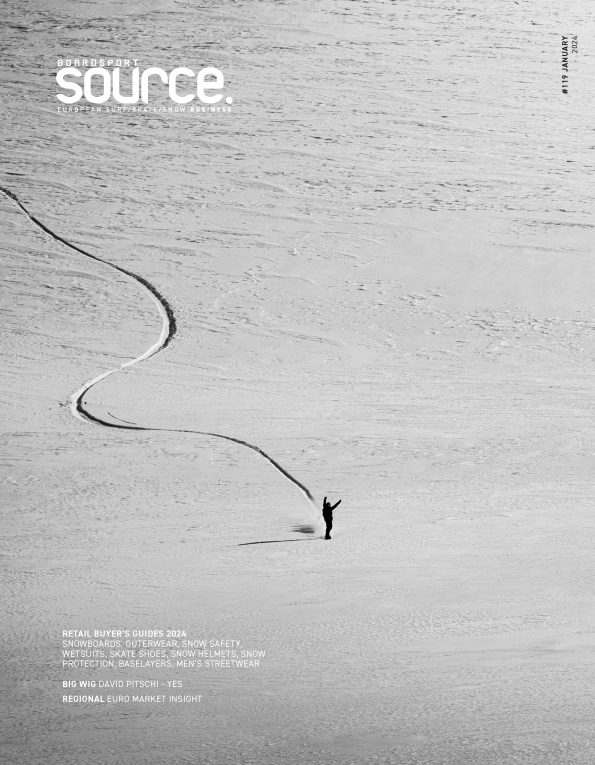Staff Sales Handbook: Snowboards 17/18
Editor’s note: Retail buyers used this guide last winter to put together their snowboard orders for this season and now we’re releasing it as a Staff Sales Handbook to provide all staff with a comprehensive overview of the 17/18 snowboard category.
Wood, steel. Carbon, perhaps. A little layer of fibreglass. The sandwich of expensive materials that pulls deeply on our heartstrings. Just why does it evoke so much anticipation, opinion, joy, jealousy and pain? Well, you’ll need more than 3000 words to answer that one, but for now, Tom Wilson-North takes a look at the best of FW17/18’s snowboards in our Staff Sales Handbook.

Nitro
STATE OF SHAPE
Evolution in shape continues. The biggest single shape trend next year centres around geometric post-blunt nose and tail forms, extra long front contact points and taper in all its forms, even after the kick on the nose. Korua’s Tranny Finder (available in a lightweight carbon version next year) embodies it, and Burton’s Dump Truck and Jones’ Mind Expander do it well too. You’ll also see unique geometrics from West Snowboarding, Nightmare and Technine and, for Lib fans, you’ll be pleased to hear that the T-Rice has a new and updated shape.
Flip the coin and there’s throwback-style, nostalgic shapes which are either reinventions of archive boards (like Winterstick’s old-is-new Roundtail and the retro SIMS Blade), or full on category comebacks, like Jones’ long, straight Lone Wolf swallow, which goes up to 174cm. Speaking of which, there are swallows abound next year too; Bataleon’s Surfer is reminiscent of a 1960s Cadillac, Endeavor’s Archetype is all about straight lines and a deep tailnotch, and Rossgnol’s gloss-drip Sushi 145 mini-swallow is a Fish-style board loaded with tech which needs to be seen to be believed.
The next big trend for mainstream snowboards is sort of a mirror of the bike industry; instead of having a cross-country and a downhill bike, now you have the long-travel enduro which does it all. In the same way, by avoiding any type of freestyle- or switch-favouring compromise on shape, these types of unashamedly directional boards negate the need for a quiver entirely and focus on what the middle-aged snowboarder demographic wants to do; ride pow and bomb the piste. Remember how fast the Yes Optimistic two winters ago? Same deal. Look out for Burton’s Deep Thinker, which has 7mm taper and an aggressive sidecut, Lib’s tapered (and excellent value) Cold Brew or Drake’s Battle which sits in a similar vein with steezy Peter Szalay graphics.
FREESTYLE CARVING
Now it’s got a decent name, the carving trend is locking in and leaning over. “There is a new generation of riders out there, bored by sloppy rocker-type decks and a general lack of actual riding technique. And things have been too focused on what the top riders are doing in the air rather than what can be done on the slope. So this carving board trend is much more tangible for a lot of snowboarders out there”, says Nitro’s Tommy Delago of their new Woodcarver and Diablo sticks. Nidecker are also showing a premium carver called the Concept, Vimana are introducing a tapered and directional version of their Continental and Palmer’s Honeycomb reissue looks to be an absolute trench-digging machine. There’s also (finally) a fresh and colourful Dupraz line of D1 variations.
Other shapes that caught our eye were Gnu’s steezy Jamie Anderson shortboard, Korua’s bold and effective Tugboat with huge nose and channelled base, Roxy’s brand new Torah Bright and Mahee’s ‘V’ base. “This is kind of like the hull of a speed boat, explains Mahee’s Creative Director Ben Rousseau. “The apex of the ‘V’ in the centreline is protected by a third metal edge which runs the length of the board, delivering a faster and much more controllable ride off-piste.”
CAMBER
Nothing much new here. As last year, the camber trend remains towards positive, flat or directional hybrid-camber boards. Reverse is retreating to freestyle, backcountry or pow-only applications.
MICRO-LINES
As esoteric and out-there shapes become more and more prevalent, there has been a tendency for brands to group together these funky-looking decks into capsule collections. One such this year is Salomon’s Hillside Collection, to celebrate ten years of the Sickstick. “We’ve contributed knowledge and design resources to Wolle Nyvelt’s passion project AESMO, and in return Wolle’s deep knowledge of shapes, construction, and skill have been applied to Hillside,” says Salomon’s PLM Baptiste Chaussignand.
Over at Neversummer, The Shaper Series is a new set of boards inspired by the Twenty Five and Swift models with a heavy focus on dynamic turning. You’ll also see Nidecker’s carving lineup, an expanded Quiver Series from Nitro and a new iteration of Burton’s well-received Family Tree. Finally, Amplid’s Centrifugal Collection is a three-board-quiver “designed to maximise the enjoyment a rider gets from toying with centrifugal forces generated during turning,” according to Amplid’s Rich Ewbank. The trio have particularly great names too; they’re called the Pentaquark, Surfari and the UNW8.
POWSURFERS
Tune into Instagram and bindingless snowboarding is everywhere; it embodies the rootsy, minimalist and hippiesque vibe so prevalent at the cutting edge of our sport today. Traditional snowboard companies are getting involved with bindingless boards: Pogo’s new Asueto combines a high end Ptex base with 3D shape, and Arbor’s new Terrapin – which saw daylight as an early release this year – is a high volume powsurfer by Brian Iguchi which boasts 50mm of taper and innovative uprise fenders in the nose.
DARK STORM
An interesting subtrend that we identified in aesthetic treatments was that of haunted, vintage, subtle and filme noir style graphics being much more widespread than regular treatments from the natural world (ie the usual stuff like mountains, trees, leaves). Whether this darker theme is a reflection of unease of an uncertain future or just designers trying to provide interesting alternatives to black is anyone’s guess. However, it does mean that topsheet interest is added via matt/gloss/reflective layering (see Niche’s beautiful Story or Capita’s all-new Navigator) or subtle pop colours (Nidecker’s Mellow, Concept and Rave). Additionally, use of transparency merges well with this aesthetic theme, with visible tech and see-through windows common in most mid-to-high end snowboard topsheets.

Nidecker | Photo Credit: David Carlier
Otherwise in graphics the classic themes remain popular; cartoons, line drawings and modern art at the busier end of things, and wood and solid matts for the plains. There are more tattoo-style graphics out there as well. “This year we did Thibaut Roux Mollard’s pro model with Sasha Masiuk, a very famous Russian tattoo artist,” says Verdad boss Démir Julià. “She has over 470,000 followers, so hopefully this’ll put us in a good position in Russia”.
Collaborations continue to be hot; the best one we saw for this year was the link up between West Snowboarding and hip hop group IAM. “We’ve listened to IAM since the back in the days of copied Panasonic tapes, so this band has been part of our entire snowboarding life,” says West’s David Lambert. Tattoo artist Baron Sigmund von Ofen is on graphic duties on this one.
KEEP IT CORE
Surprisingly, look forward to gigantic leaps forward in snowboard construction this year. Particularly in cores. At Amplid you’ll see a new multidirectional composite core layer called Antiphase which promises to erase chatter, and Head are using a light and stiff new synthetic honeycomb material called Hexlight. There’s a new Quad Carbon V pattern from SIMS, and a new wood, bamboo and basalt core for extra woosh on Borealis’ ultra-premium Shaman. Rossignol are using their L.I.T.E Frame urethane profiling with L.I.T.E Grip which, in conjunction with their tweaked RadCut shape, “crashes through Magne-Traction barriers. We’re bringing grip on demand or necessity, not permanently”, claims Rossi’s Category Manager Arnaud Repa. There’s also an upgrade to the Kush-control urethane features in Flow’s cores. Meanwhile, Nitro’s successful Slash gets a new lightweight balsa heart with beech stringers, and Wi-Me use a new fibreglass-free composite and prepreg resin process borrowed from the aerospace industry for toughness and bonus eco points.
ORIGINAL RESIN
Resin, interestingly, is a hot topic right now. And no, we don’t mean the sticky Afghan variety. New resins used in snowboard manufacturing are recyclable and have some fairly interesting properties. “Our Theme board has our new resin which we’re calling Recyclamine,” explains Niche’s Ana van Pelt. “It’s as durable, lightweight and fun to ride as ever, but now at the end of its life cycle, we can reclaim and fully recycle all the board’s structural components and turn them into new things, like binding discs or surfboard fins.” We saw a similar VOC-free resin from Yunika, 55% recycled biomass Greenpoxy resin from Borealis, and Burton are going linewide with their proprietary and planet-friendly Super Sap. They’re also rolling out a new eco hardener from Conorra called ReRez on their Working Stiff, which allows them to reuse and better recycle scraps left over from the shaping of the board. “This is just the tip of the iceberg for this material– we’re excited to push this out across our line”, enthuses Burton PLM Lesley Betts.
COMPONENTRY
What about the rest of the snowboard? Well, as you’d expect, there are incremental increases in base material qualities…West upgrade the line to Iso Sport’s NHS base, and Lobster move their pro-models and Sender decks to a 7000 base. Endeavor will be revealing their Seamless Sidewalls v2, which are made with a much quicker and more efficient process, and Light are showing a gorgeous new see-through coloured stretch-resistant gloss topsheet. Seems less is more on topsheets; neither DC nor Plum will be using them, the latter screenprinting between two layers of varnish to save weight.
GRASSROOTS
It’s like it’s 1993 all over again; small snowboard brands abound. 2017/2018 sees many little companies bringing new shapes, distribution strategies and attitudes to market, all the while leveraging modern B2C engagement channels to create huge buzz. “It is a pretty amazing feeling to be able to do what ever you want and not have to cross any red tape,” explains Joe Sexton, founder of Public Snowboards. Korua’s Nicholas Wolken agrees: “We’re stoked. Small companies are healthy competition for big established brands and it’s pushing snowboarding in directions that are more relatable to end consumers again.”
In the US, Joe Suta is the guy behind Nightmare Snowboards (who are also responsible for alternative tradeshow Parts & Labor). He sees a big difference between the big guys and the little guys. “Most other snowboard brands create their product for people who want to go on vacation to be a ‘snowboarder’ for the weekend, Nightmare builds boards for people who live snowboarding, not for the weekend warrior. Stop flooding the market and use your own core values to stand up for a new industry with fresh and new responsible ethics,” he told us. It’s something of a renaissance, especially for the small builders. Hightide is a Canadian company who build everything out of their shop in Pemberton, BC – they cited their size as an advantage, allowing them rapid prototyping turnaround. Smaller brands also allow B2C custom builds, and we saw Winterstick and Wi-Me launching custom build programmes next year, Winterstick building theirs out of a new factory at the base of Sugarloaf, Maine.
Whilst grassroots is well and good, a few more established brands raised an eyebrow to the trend, questioning new companies’ reliability when it comes to the nuts-and-bolts of distribution, delivery and service in the long run. So make sure there’s trousers behind the mouth before you sign on the dotted line.
NEW WAYS OF SELLING
Ask anyone working in a snowboard shop today, and you’ll get the same answer. Showrooming is the biggest challenge to retail today, both online and off. How do we stop your client wasting your team’s time and getting great – free – advice, then to just go pick up the board cheaper elsewhere? Luckily, solutions are out there, and most of them involve picking the right suppliers. “We believe that retailers are looking for brands with limited availability and a clear brand proposition, says Amplid’s Rich Ewbank. “The only way to avoid showrooming is to make sure that your products aren’t available from every pile-em-high warehouse on the internet, Ebay or Amazon at heavily discounted prices. The retailers’ search for something different and for more limited collections which can help to make their shops unique, is helping small brands like Amplid to get their foot in the door”.
Snowboarding has so far been able to mostly avoid the rise of “online direct sales only,” seen in other industries. B2C snowboard brands have been unable to get a foothold so far, so the traditional BBC reseller model remains the norm. However, with an ever-decreasing amount of retailers who are able to carry wide product lines, more and more brands are turning to direct sales in some way in order to provide product to the people who ultimately want to use it. Saying that, our conversations with brands generally – fortunately – showed a reticence to compete with their retail network by selling direct. But in today’s market conditions, who knows. Expect to be presented new distribution models in the short- and middle-terms.

Bataleon – Photo by Cyril Muller
There’s been much rumblings out there about two-year product life cycles to dissuade discounting and allow retailers to make margin for longer. But so far, take-up has been slow. “This idea comes from the ski industry. And we are not willing to follow ski ideas. But we are willing to offer fresh new products each season,” huffs West’s David Lambert. Bataleon’s Dennis Dusseldorp agrees: “I can’t see it happening anytime soon either. It would only work if all the brands cooperated and we know that many brands are run by suits far away from the snow who just want to see yearly growth on an Excel sheet.” That said, next year you’ll definitely see more carryover products in shops – Korua, Hightide, BuddyBuddy and Jones will all have timeless SKUs, Jones with 8 – count ‘em – carryover board models “including the five most expensive models we produce,” confirms Marketing and Team Manager, Seth Lightcap. “We have heard dealer request for carryover models loud and clear.”
SPLITBOARDS
Splitboarding continues to perform well, and next year sees a clutch of noteworthy new models. Burton extend their Family Tree line to include a blunt, setback and geometric Dump Truck Split, and Capita début their Neo Slasher which is the uphill cousin of their cult favourite Charlie Slasher freerider. Everything is getting a bit lighter too, with lightweight splits top of the list at Amplid and Goodboards…but hopefully not at the expense of edge and base thickness.
Whilst there’s tech innovation in splitboard bindings and skin systems every year, the boards themselves seem to have arrived at a standard of acceptable quality. Now it’s about democratising the marketplace and growing the userbase. “To push this segment and our Powder Division boards forward, we are piloting our Powder To The People program that puts powder boards and splitboards into stores for hire at great prices. We want riders to be able to demo this stuff as easily as possible,” says Rome’s Philipp Kammerer.

HEAD
CONCLUSION
So there you have it. Snowboarding technology is moving forward, and the boards are looking better and easier-to-sell than ever – which is definitely a good thing in a marketplace full of new challenges.
However, as we all know, the days of people waiting all summer with baited breath to see the new gear are over. Now, anyone very interested sees the stuff as soon as the catalogues leak online – around Christmas – so by the time it’s in the shops nine months later “it’s old news and really ought to be on sale.” So in the absence of shorter lead times, our main market for selling at full-price has become, oddly, anyone except those ‘very interested’ people. Which means we’re selling to once a year participants, or casual / occasional riders. It’s now our job to convert these guys and girls into loyal and returning regular snowboarders.
With that, let’s try and keep things somewhat positive. So over to Yes’s Alex Warburton to finish. “We hear too many stories about the dire state of the industry, but in reality we’re enjoying the most creative and eclectic time in our sports’ history. Smallish boutique brands are a reflection of that. This is coming from a smallish boutique brand, mind you…”




